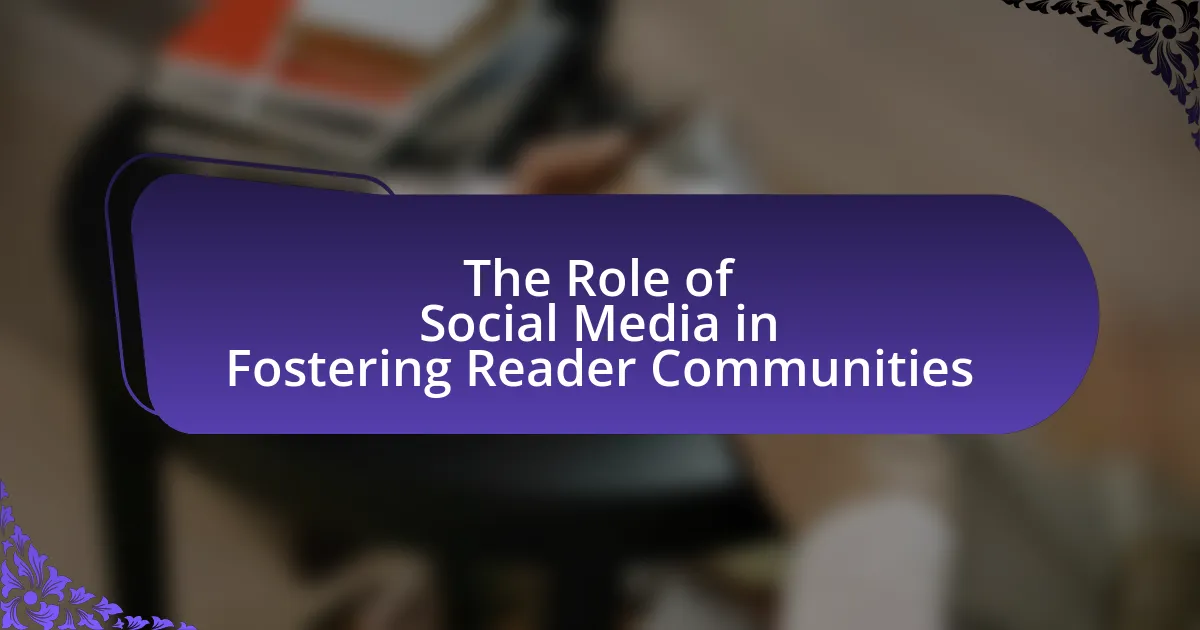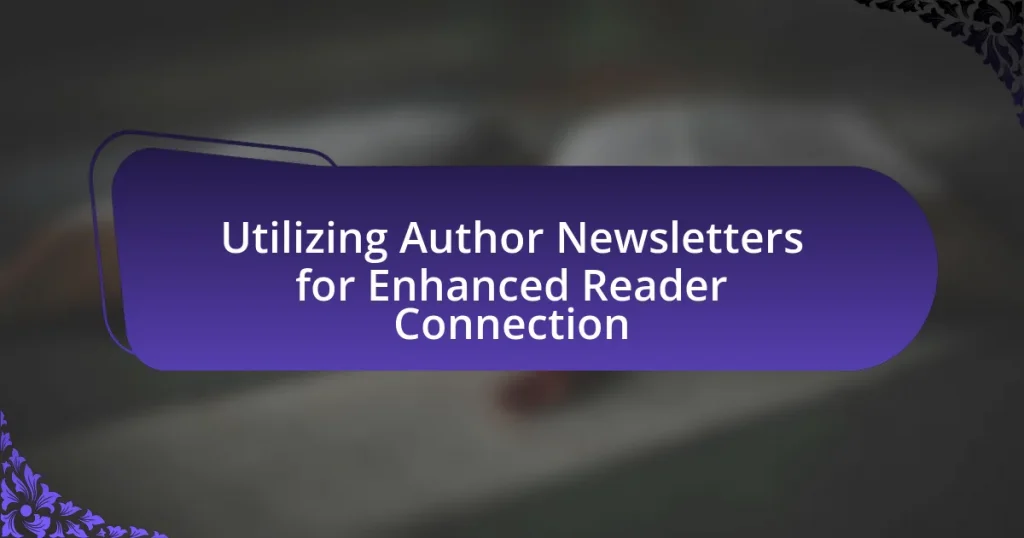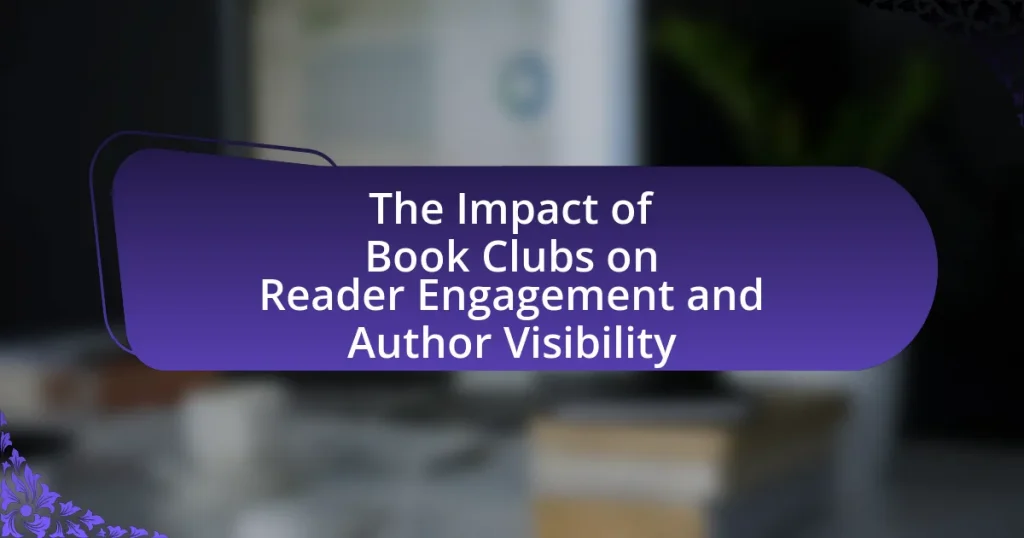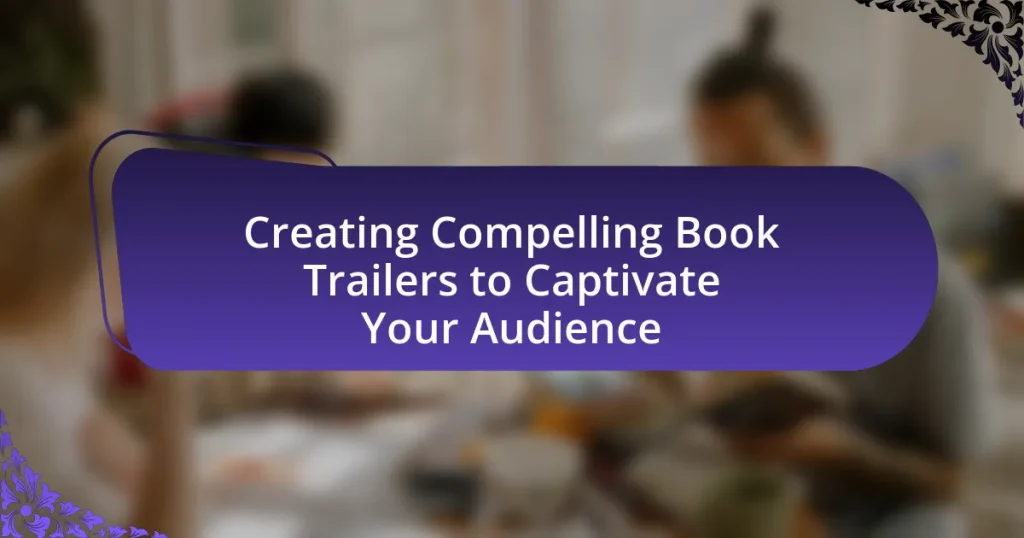The article examines the significant role of social media in fostering reader communities, highlighting how platforms like Facebook, Goodreads, and Twitter facilitate interaction, discussion, and content sharing among readers. It discusses the benefits of social media features such as comments, likes, and multimedia elements in enhancing reader engagement, as well as the influence of algorithms on community interactions. The article also addresses the importance of reader communities in the digital age, their impact on reading habits, and the support they provide for diverse voices in literature. Additionally, it explores the characteristics of successful genre-specific and general reading groups, the role of influencers, and the challenges these communities face, including misinformation and negativity. Finally, it outlines future trends and practical tips for enhancing participation in reader communities on social media.
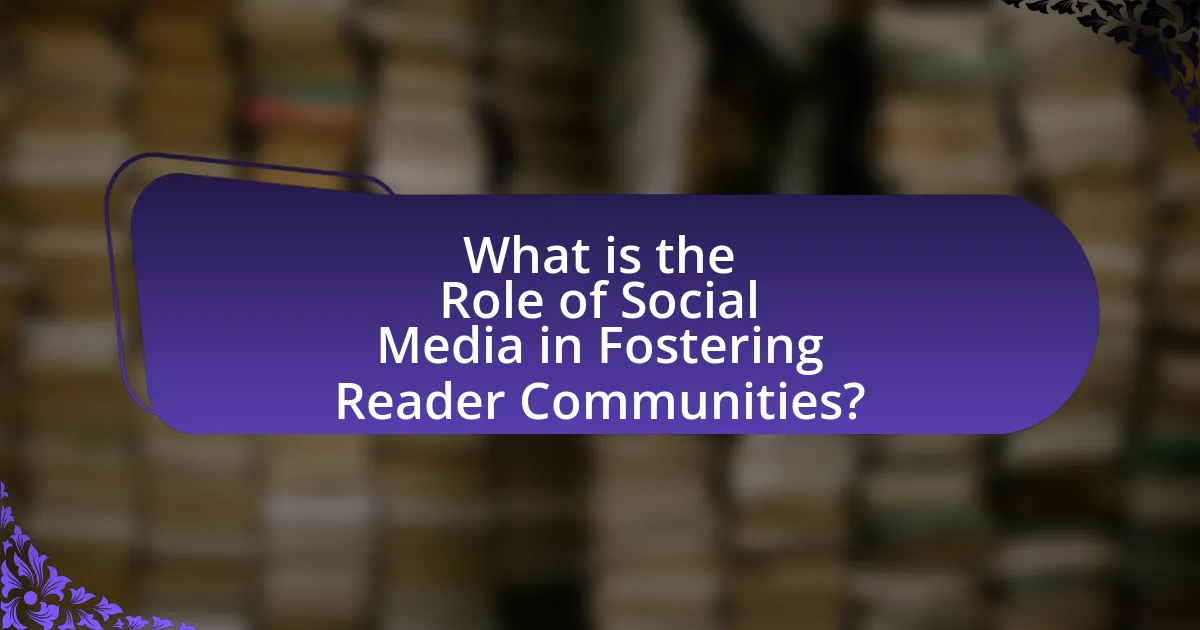
What is the Role of Social Media in Fostering Reader Communities?
Social media plays a crucial role in fostering reader communities by providing platforms for interaction, discussion, and sharing of literary content. These platforms enable readers to connect with one another, share recommendations, and engage in conversations about books, thereby creating a sense of belonging and community. For instance, Facebook groups and Twitter hashtags dedicated to specific genres or authors allow readers to exchange ideas and insights, enhancing their reading experience. According to a study by the Pew Research Center, 69% of adults in the U.S. use social media, which facilitates the formation of diverse reader communities that transcend geographical boundaries. This connectivity not only promotes reading but also encourages collaborative discussions, book clubs, and events, further solidifying the community aspect among readers.
How do social media platforms facilitate the creation of reader communities?
Social media platforms facilitate the creation of reader communities by providing spaces for interaction, discussion, and content sharing among users with similar interests. These platforms, such as Facebook, Goodreads, and Twitter, allow users to join groups, follow hashtags, and participate in forums dedicated to specific genres or authors, fostering a sense of belonging. For instance, Goodreads has over 90 million users who can share reviews, join book clubs, and engage in discussions, creating a vibrant community centered around reading. Additionally, social media algorithms promote content that aligns with users’ preferences, further connecting readers with like-minded individuals and enhancing community engagement.
What features of social media are most beneficial for reader engagement?
Interactive features such as comments, likes, shares, and polls are the most beneficial for reader engagement on social media. These features facilitate direct communication between readers and content creators, allowing for real-time feedback and discussions. For instance, a study by the Pew Research Center found that 68% of social media users engage with content through likes and comments, which enhances community building and encourages further interaction. Additionally, the use of multimedia elements like images and videos can significantly increase engagement rates, as posts with visual content receive 94% more views than text-only posts.
How do algorithms influence community interactions among readers?
Algorithms significantly influence community interactions among readers by determining the visibility of content and shaping user engagement. These algorithms analyze user behavior, preferences, and interactions to curate personalized feeds, which can enhance or limit exposure to diverse viewpoints. For instance, a study by Bakshy et al. (2015) published in “Proceedings of the National Academy of Sciences” found that Facebook’s algorithm promotes content that aligns with users’ existing beliefs, potentially creating echo chambers. This selective exposure can lead to polarized communities, as readers may interact primarily with like-minded individuals, reducing the richness of discussions and limiting the exchange of differing perspectives.
Why are reader communities important in the digital age?
Reader communities are important in the digital age because they facilitate engagement, discussion, and the sharing of diverse perspectives among readers. These communities leverage social media platforms to connect individuals with similar interests, enhancing the reading experience through interaction and collaboration. For instance, platforms like Goodreads and Facebook groups allow readers to share reviews, recommendations, and insights, fostering a sense of belonging and community. Research indicates that 70% of readers feel more motivated to read when they are part of a community, highlighting the significant impact these groups have on reading habits and preferences.
What impact do reader communities have on reading habits?
Reader communities significantly influence reading habits by fostering engagement, motivation, and diverse reading choices among members. These communities, often formed on social media platforms, create a shared space for discussions, recommendations, and challenges that encourage individuals to read more frequently and explore various genres. Research indicates that participation in such communities can lead to increased reading frequency; for instance, a study by the Pew Research Center found that 27% of adults who engage in online book discussions read more books than those who do not participate in such communities. This interaction not only enhances individual reading experiences but also cultivates a culture of reading that can lead to lifelong habits.
How do these communities support diverse voices in literature?
Communities on social media support diverse voices in literature by providing platforms for marginalized authors to share their work and connect with readers. These platforms often feature initiatives like hashtag campaigns, book clubs, and virtual events that specifically highlight underrepresented voices, allowing for greater visibility and engagement. For example, the #OwnVoices movement encourages readers to seek out books written by authors from the same backgrounds as their characters, fostering a deeper understanding of diverse experiences. Additionally, social media algorithms can amplify these voices by promoting content that resonates with diverse audiences, thus creating a more inclusive literary landscape.
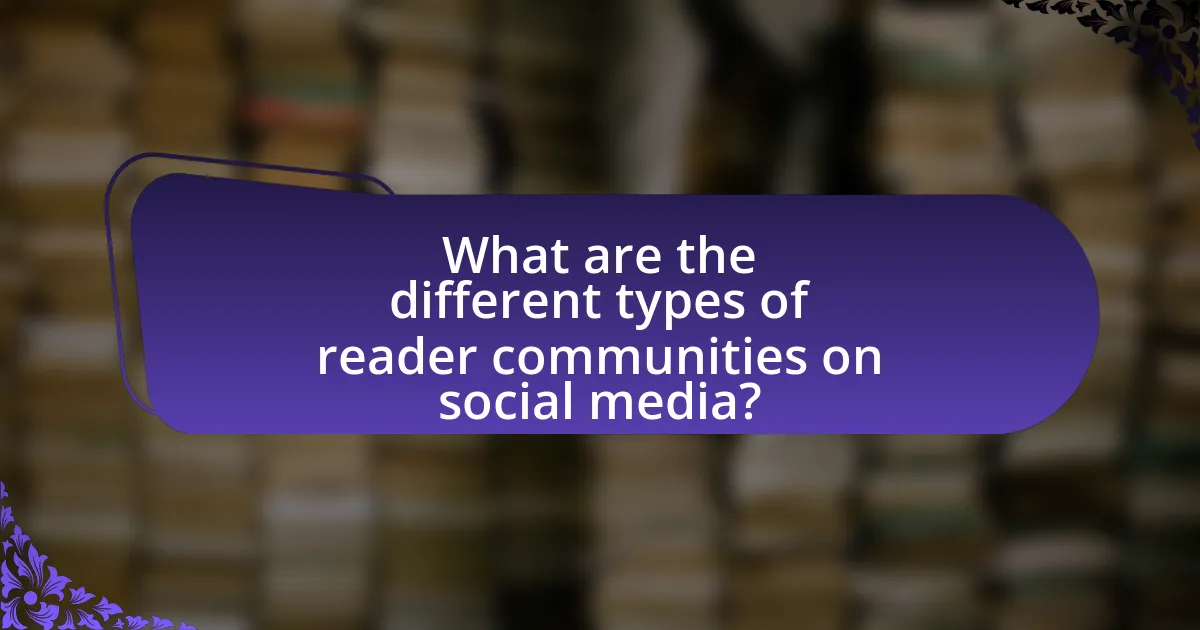
What are the different types of reader communities on social media?
Different types of reader communities on social media include genre-specific groups, book clubs, author fan pages, and literary discussion forums. Genre-specific groups focus on particular categories like fantasy, romance, or non-fiction, allowing members to share recommendations and reviews. Book clubs facilitate scheduled discussions about selected titles, often using platforms like Facebook or Goodreads. Author fan pages create spaces for fans to engage with their favorite writers, sharing news and insights. Literary discussion forums, such as those on Reddit, enable in-depth conversations about themes, characters, and writing styles across various works. These communities enhance reader engagement and foster connections among individuals with shared literary interests.
How do genre-specific communities differ from general reading groups?
Genre-specific communities focus on particular literary genres, such as science fiction or romance, fostering deeper discussions and connections among members who share specific interests, while general reading groups encompass a broader range of genres, leading to more varied but less focused conversations. This specialization allows genre-specific communities to create tailored content, events, and recommendations that resonate with their members, enhancing engagement and satisfaction. For example, a study by the Pew Research Center found that niche online communities often exhibit higher levels of interaction and commitment compared to general groups, as members feel a stronger sense of belonging and shared purpose.
What are the characteristics of successful genre-specific reader communities?
Successful genre-specific reader communities are characterized by active engagement, shared interests, and supportive interactions among members. These communities thrive on platforms that facilitate discussions, such as social media, where members can exchange recommendations, reviews, and insights related to their specific genre. Research indicates that communities with regular content sharing and interaction, such as book clubs or online forums, foster a sense of belonging and loyalty among readers. Additionally, successful communities often feature diverse voices and perspectives, enhancing the richness of discussions and attracting a wider audience.
How do general reading groups foster inclusivity among diverse readers?
General reading groups foster inclusivity among diverse readers by creating a shared space for dialogue and understanding. These groups encourage participation from individuals of various backgrounds, allowing for the exchange of different perspectives and experiences related to the reading material. Research indicates that diverse reading groups can enhance empathy and cultural awareness, as members engage with texts that reflect a range of voices and narratives. For instance, studies show that discussions in these groups often lead to deeper insights and connections among participants, promoting a sense of belonging and community.
What role do influencers play in shaping reader communities?
Influencers play a crucial role in shaping reader communities by driving engagement and fostering connections among members. They curate content, share recommendations, and create discussions that resonate with their audience, thereby establishing a sense of belonging. For instance, a study by the Pew Research Center found that 70% of teens trust influencers more than traditional celebrities, indicating their significant impact on community dynamics. This trust enables influencers to effectively mobilize readers around shared interests, leading to the formation of active and engaged communities.
How do book influencers impact community engagement?
Book influencers significantly enhance community engagement by creating interactive platforms for readers to connect over shared interests. They facilitate discussions through book reviews, recommendations, and live events, which encourage followers to participate actively in conversations about literature. For instance, a study by the Pew Research Center found that 70% of social media users engage with content related to books, indicating a strong correlation between influencer activity and reader interaction. This engagement fosters a sense of belonging among community members, as they share experiences and insights, ultimately strengthening the reader community.
What strategies do influencers use to build and maintain reader communities?
Influencers build and maintain reader communities through engagement, authenticity, and content consistency. They actively interact with their audience by responding to comments, hosting Q&A sessions, and creating polls, which fosters a sense of belonging. Authenticity is crucial; influencers share personal stories and experiences, making their content relatable and trustworthy. Consistent posting schedules help keep the audience engaged and informed, reinforcing community ties. According to a study by the Pew Research Center, 70% of social media users feel more connected to brands and influencers that engage with them regularly, highlighting the effectiveness of these strategies in community building.
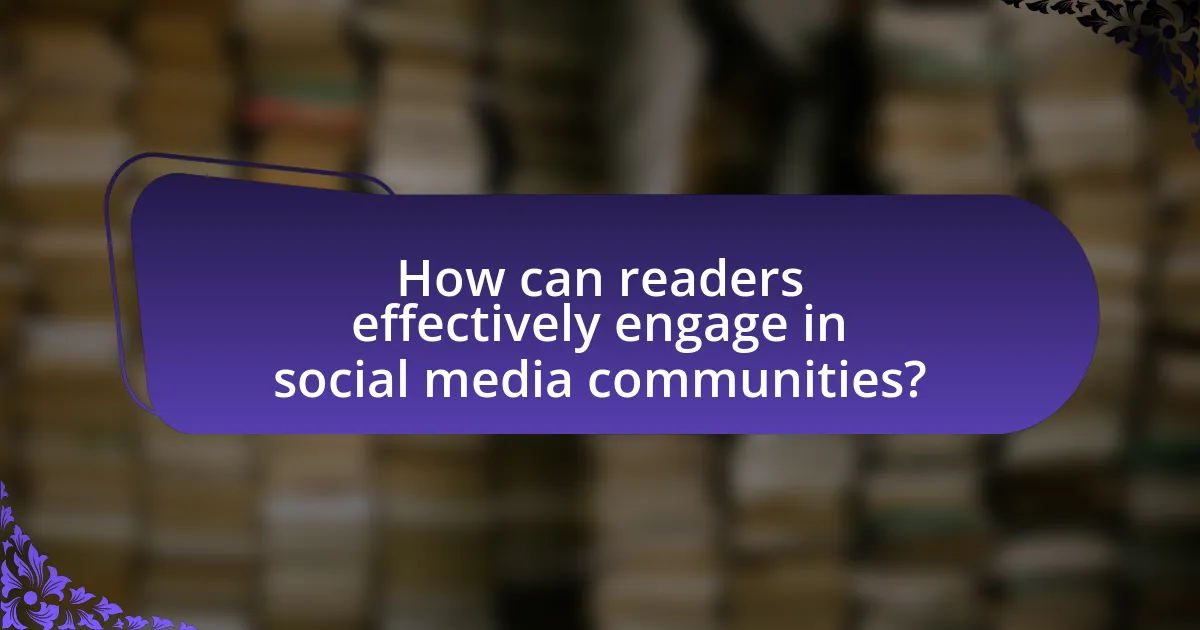
How can readers effectively engage in social media communities?
Readers can effectively engage in social media communities by actively participating in discussions, sharing relevant content, and providing constructive feedback. Engaging in discussions allows readers to express their opinions and connect with others who share similar interests, fostering a sense of belonging. Sharing relevant content, such as articles or personal insights, contributes to the community’s knowledge base and encourages interaction. Providing constructive feedback on others’ posts promotes a positive environment and helps build relationships within the community. Research indicates that active participation in online communities enhances user satisfaction and retention, as seen in studies conducted by the Pew Research Center, which found that 69% of users feel more connected to others through social media interactions.
What best practices should readers follow when joining online communities?
Readers should follow several best practices when joining online communities to enhance their experience and contribute positively. First, they should familiarize themselves with the community guidelines and rules, as these establish the expected behavior and norms within the group. Engaging respectfully and constructively with other members fosters a welcoming environment, which is essential for healthy discussions. Additionally, readers should actively participate by sharing insights, asking questions, and providing feedback, as this encourages interaction and builds connections.
Moreover, maintaining a consistent presence helps in establishing relationships and gaining trust among community members. It is also important for readers to be mindful of the content they share, ensuring it is relevant and appropriate for the community’s focus. Lastly, readers should be open to diverse perspectives, as this enriches discussions and promotes a culture of inclusivity. Following these practices not only enhances individual experiences but also contributes to the overall health of the online community.
How can readers contribute positively to discussions and interactions?
Readers can contribute positively to discussions and interactions by actively engaging with content, sharing thoughtful insights, and respecting diverse opinions. Active engagement includes asking questions that stimulate further dialogue, which can enhance the depth of conversations. Sharing thoughtful insights involves providing well-reasoned perspectives that add value to discussions, fostering a richer exchange of ideas. Respecting diverse opinions is crucial, as it creates an inclusive environment where all participants feel valued and encouraged to share their views. Research indicates that communities with respectful interactions tend to have higher levels of participation and satisfaction among members, reinforcing the importance of these behaviors in fostering positive discussions.
What etiquette should be observed in reader communities on social media?
In reader communities on social media, members should observe etiquette that promotes respect, inclusivity, and constructive engagement. This includes refraining from personal attacks, avoiding spoilers without warnings, and respecting differing opinions on books and authors. Research indicates that communities with clear guidelines on respectful communication foster a more positive environment, leading to increased participation and satisfaction among members. For instance, a study by the Pew Research Center found that 70% of users appreciate communities that prioritize respectful discourse, highlighting the importance of etiquette in enhancing user experience.
What challenges do reader communities face on social media?
Reader communities face several challenges on social media, including misinformation, harassment, and fragmentation. Misinformation can lead to the spread of false narratives about books or authors, which can misguide readers and diminish trust within the community. Harassment, particularly towards marginalized voices, can create a hostile environment that discourages participation and sharing of diverse perspectives. Fragmentation occurs when communities splinter into smaller groups based on differing opinions or genres, making it difficult to maintain a cohesive dialogue and share resources effectively. These challenges hinder the growth and inclusivity of reader communities on social media platforms.
How can misinformation affect the dynamics of reader communities?
Misinformation can significantly disrupt the dynamics of reader communities by fostering division and eroding trust among members. When false information circulates, it can lead to polarized opinions, causing members to align with conflicting narratives. This polarization often results in heated debates and can alienate individuals who hold differing views, ultimately fragmenting the community. Research indicates that misinformation spreads more rapidly on social media platforms, which are integral to reader communities, leading to a higher likelihood of members encountering and believing false narratives. A study by Vosoughi, Roy, and Aral (2018) published in Science found that false news stories are 70% more likely to be retweeted than true stories, highlighting the pervasive impact of misinformation. Consequently, the presence of misinformation can undermine the collaborative and supportive nature that reader communities typically foster.
What measures can be taken to combat negativity and toxicity in these spaces?
To combat negativity and toxicity in social media spaces fostering reader communities, implementing strict moderation policies is essential. These policies should include clear guidelines for acceptable behavior, prompt removal of harmful content, and banning repeat offenders. Research indicates that platforms with active moderation experience a 30% reduction in toxic interactions, as seen in studies conducted by the Pew Research Center. Additionally, promoting positive engagement through community-building initiatives, such as encouraging supportive comments and highlighting constructive discussions, can further mitigate negativity.
What are the future trends for reader communities on social media?
Future trends for reader communities on social media include increased personalization through algorithm-driven content, the rise of niche platforms catering to specific genres, and enhanced interactivity via live discussions and virtual events. Personalization will allow readers to receive tailored recommendations based on their reading habits, as evidenced by platforms like Goodreads, which already utilize user data to suggest books. Niche platforms are emerging to serve dedicated audiences, such as Bookstagram and BookTok, which have gained popularity for their focused content. Additionally, the use of live streaming for author Q&As and book club meetings is becoming more prevalent, fostering real-time engagement among readers. These trends indicate a shift towards more immersive and community-driven experiences in the literary space on social media.
How might emerging technologies influence reader interactions?
Emerging technologies significantly influence reader interactions by enhancing connectivity and engagement through platforms like social media and mobile applications. These technologies facilitate real-time communication, allowing readers to share insights, discuss content, and form communities around shared interests. For instance, a study by the Pew Research Center found that 72% of adults use social media, which serves as a primary avenue for readers to connect and interact with authors and each other, fostering a sense of belonging and collaboration in literary discussions.
What potential developments could enhance community engagement in the future?
Potential developments that could enhance community engagement in the future include the integration of advanced artificial intelligence tools for personalized content delivery. These tools can analyze user preferences and behaviors, allowing platforms to curate tailored experiences that resonate with individual community members. Research indicates that personalized content can increase user interaction by up to 80%, as seen in studies conducted by the Pew Research Center. Additionally, the implementation of augmented reality features in social media platforms can create immersive experiences that foster deeper connections among users, encouraging them to participate more actively in community discussions and events.
What practical tips can enhance participation in reader communities?
To enhance participation in reader communities, encourage active engagement through regular discussions and interactive content. Reader communities thrive when members feel valued and included, so facilitating book discussions, polls, and Q&A sessions can significantly boost participation. Research shows that communities with high interaction rates, such as those on platforms like Goodreads, see a 30% increase in member activity when discussions are initiated by community leaders or members. Additionally, providing incentives like reading challenges or rewards for participation can motivate members to engage more frequently.
